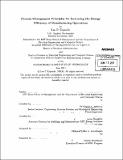| dc.contributor.advisor | Daniel E. Whitney and Sarah Slaughter. | en_US |
| dc.contributor.author | Espindle, L. P. (Leo P.) | en_US |
| dc.contributor.other | Leaders for Manufacturing Program. | en_US |
| dc.date.accessioned | 2011-09-27T18:39:21Z | |
| dc.date.available | 2011-09-27T18:39:21Z | |
| dc.date.copyright | 2011 | en_US |
| dc.date.issued | 2011 | en_US |
| dc.identifier.uri | http://hdl.handle.net/1721.1/66070 | |
| dc.description | Thesis (M.B.A.)--Massachusetts Institute of Technology, Sloan School of Management; and, (S.M.)--Massachusetts Institute of Technology, Dept. of Electrical Engineering and Computer Science; in conjunction with the Leaders for Manufacturing Program at MIT, 2011. | en_US |
| dc.description | Cataloged from PDF version of thesis. | en_US |
| dc.description | Includes bibliographical references (p. 81-84). | en_US |
| dc.description.abstract | Energy usage is a significant operating cost for manufacturing facilities in the United States, and interest in energy management has been rising of late, 2, 3]. One approach, recommended by the Environmental Protection Agency (EPA), is to piggyback off of an existing lean program to reduce energy waste in manufacturing processes(4]. Just such a pilot program has recently been launched in a major manufacturing facility at Raytheon, where approximately 48% of the facilities' total energy is used on manufacturing processes. The program focuses on proven process management approaches and rides the coattails of the existing lean program at a major manufacturing facility by creating a pull for continuous improvement ideas[1]. The goal this thesis was to increase the efficacy of the existing program, and to develop a practical roadmap to guide energy managers seeking to execute such programs in manufacturing on the shop floor. We investigated three methods to enhance the program. One was to apply the Design, Measure, Analyze, Improve, Control (DMAIC) method, made popular in Six Sigma literature, to the energy waste reduction efforts of a manufacturing area. By shifting focus to more energy intensive equipment, the area quadrupled the amount of energy savings per improvement, and is in line to achieve a 10% reduction in electricity usage(5, 4]. The second method was to provide real-time feedback on electricity usage of energy intensive equipment to workers in a manufacturing cell. During an experimental period, we found that feedback ultimately engaged area operations managers who instituted an auditing program that reduced waste by 43% (or a 26% total reduction in usage) over a short period of time[6, 7, 8, 9]. The third method was to right-size equipment based on customer demand. An analysis of this approach based on field experience revealed that major savings (50% or more reduction in electricity usage) on targeted systems can be expected as companies remove "monument" equipment in supporting smaller and more responsive process flows such as true cellular manufacturing[3, 4]. In summary, we found that application of continuous improvement principles can positively impact energy efficiency programs at manufacturing facilities. In addition the three methods are different in cost and longevity, with the DMAIC and feedback at low cost and immediate impact (but potentially fading effectiveness), and right-sizing at higher cost, but producing longer term and potentially more durable savings. | en_US |
| dc.description.statementofresponsibility | by Leo P. Espindle. | en_US |
| dc.format.extent | 84 p. | en_US |
| dc.language.iso | eng | en_US |
| dc.publisher | Massachusetts Institute of Technology | en_US |
| dc.rights | M.I.T. theses are protected by
copyright. They may be viewed from this source for any purpose, but
reproduction or distribution in any format is prohibited without written
permission. See provided URL for inquiries about permission. | en_US |
| dc.rights.uri | http://dspace.mit.edu/handle/1721.1/7582 | en_US |
| dc.subject | Sloan School of Management. | en_US |
| dc.subject | Electrical Engineering and Computer Science. | en_US |
| dc.subject | Leaders for Manufacturing Program. | en_US |
| dc.title | Process management principles for increasing the energy efficiency of manufacturing operations | en_US |
| dc.type | Thesis | en_US |
| dc.description.degree | S.M. | en_US |
| dc.description.degree | M.B.A. | en_US |
| dc.contributor.department | Leaders for Manufacturing Program at MIT | en_US |
| dc.contributor.department | Massachusetts Institute of Technology. Department of Electrical Engineering and Computer Science | |
| dc.contributor.department | Sloan School of Management | |
| dc.identifier.oclc | 753706940 | en_US |
